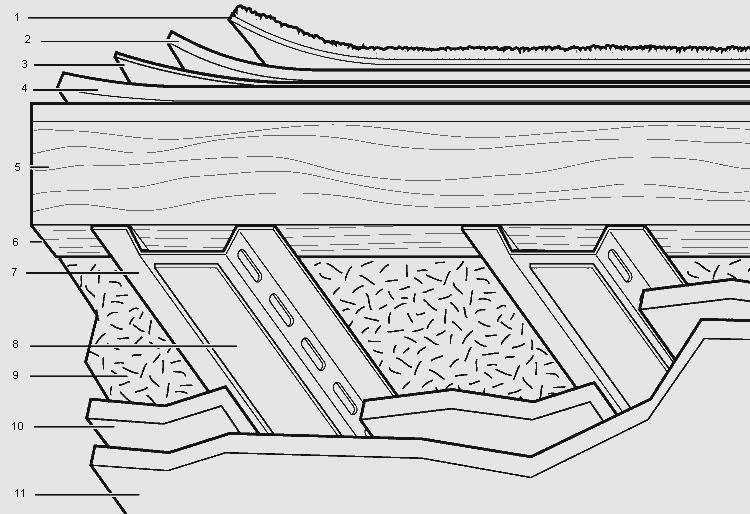soundproofing
soundproofing checklist for floors
- Isolation try to isolate the vibrating and resonant surfaces
- absorbtion add sound absorbing layers to reflecting surfaces
- decoupling, decouple joined masses to prevent transmission of vibrations
- increase mass, the heavier the harder it is for sound to cause movement, vibration, and transmission
- damping, flexible materials absorb and damp vibration
- sealing, seal up air gaps movement of air transmits sound.
Using Soundproofing noise barrier material.
Sound transfer through floors and ceilings is a continuing noise control problem, especially in older buildings.
There are two main issues regarding noise transfer:
- airborne sound
- impact noise.
Each are different and require separate treatments. Airborne sound is most easily dealt with.
Using a barrier mat.
Impact noise is dealt with by using a Sealed subfloor construction.
Normally, you need both.
Barrier mat should be fairly heavy (the heavier the better), (1 Lb per Sq. Ft!)>, underlay as heavy as lead that provides a soundproofing layer on the floor and under the carpet and padding for noise control.
It should be a tough, wear resistant material that can be placed on or under hard floors to make them more comfortable by reducing impact while slowing noise transfer above and below.
When used as an underlay for hardwood floors or tile, it reduces sound reflection and transfer dramatically.
Underlays can also be used on walls and ceilings.
When installed inside the wall, they can more than doubles the Sound Transfer Coefficient.
For example, a standard hollow sheetrock wall, with 1/2" Gypsum board on metal studs has a STC rating of about 23. (Ordinary conversation through it can be understood). Adding barrier can increase it to about 53! (Loud shouting is not heard). Stapling or glueing the material to the wall, then cover with sheetrock- tape off and paint. If you want more sound reduction? Use more layers of barrier.
Foam backing mat is recommended under carpets as it provides a vibration cushion, floating barrier just off the floor. This helps reduce footfall and impact noise.
Barriers without foam cushion would be under the subfloor or in walls and ceilings or as second layer to increase sound reduction even more.
Typically used this way: seal subfloor cracks, gaps with acoustical caulk first. Lay barrier, caulk edges and seal with metal tape.
Cover with carpet pad and carpet.
If using the one with and without foam backing together, place the foam backed material down first. Install 90 degrees to each other. Important!
Don't skip the step of inspecting and caulking the gaps and seams of your bare subfloor! Use metal tape, too..
"Double drywall" technique described in the resilient channels page, it provides the ultimate in sound reduction.
Same as above for homes and offices, but without the foam backing.
Also available with peel-off backing!
(Eliminates the mess and odor of adhesive and is easier to install on walls.)
1/4" closed cell foam bonded for superior noise damping.
Flammability: It meets certain UL requirements, but is not FAA approved for certified aircraft. (Homebuilt OK).
Use under machinery, speakers and health machines for noise control into and through the floor!
You'll need at least a 3'-4' margin of barrier around your running machine to reduce flanking sound from penetrating down through the floor.
Vibration damping pads can also be added too!
Dampling Pad: Now, a brand new product for reducing impact noise for under hardwood and tile floors!:
SEALING OF "Sub-Floor"
reduces impact noise created by walking on hardwood or tile floors.
Many barrier mats work well for drywall panels, too.
There are many ways to use materials in combination
 Method of increasing airborn impact sound insulation of an existing floor/ceiling structure
Method of increasing airborn impact sound insulation of an existing floor/ceiling structure
- Existing floor/ceiling structure
- Pad
- carpet
- Resilient bar channel
- wood studding
- AMW
- Gypsum plasterboard ceiling

- Carpet
- Carpet pad (use Rebond)
- Vinyl
- Dimple sub floor
- Existing floor ceiling
- Joists
- Resilient channel
- Padding tape
- AMW
- closed cell foam
- Gypsum plaster board ceiling
 Method of increasing airborn impact sound insulation of an existing floor/ceiling structure
Method of increasing airborn impact sound insulation of an existing floor/ceiling structure
